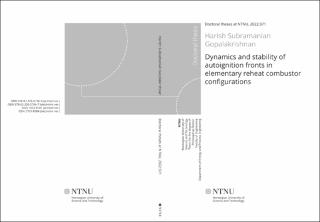| dc.contributor.advisor | Moeck, Jonas P. | |
| dc.contributor.advisor | Gruber, Andrea | |
| dc.contributor.author | Gopalakrishnan, Harish Subramanian | |
| dc.date.accessioned | 2022-11-21T10:08:59Z | |
| dc.date.available | 2022-11-21T10:08:59Z | |
| dc.date.issued | 2022 | |
| dc.identifier.isbn | 978-82-326-5766-7 | |
| dc.identifier.issn | 2703-8084 | |
| dc.identifier.uri | https://hdl.handle.net/11250/3033093 | |
| dc.description.abstract | Stringent regulations on greenhouse gas emissions from gas turbines used for land-based and aircraft applications has resulted in a gradual transition towards carbon-free fuels such as hydrogen. Conventional single-stage combustor architectures, originally designed to operate on natural gas, face challenges in burning hydrogen efficiently. These challenges basically stem from the high reactivity of the hydrogen fuel, resulting in a risk of flame flashback and consequent damage to the engine components. A staged combustion architecture, containing a propagation-stabilized flame in the first stage and an autoignition-stabilized flame in the second reheat stage, allows for efficient power production both with natural gas and fuels with high hydrogen contents by varying the fuel splits between the first and the second stages.
The fascinating phenomena of combustion instability, which results from the unsteady interactions between the flame dynamics and the acoustic field of the combustion chamber, can result in self-sustained flame and flow oscillations. This undesirable phenomenon, also know as thermoacoustic instability, can result in large amplitude oscillations in the flow quantities such as pressure and heat release rate, which can cause structural damage, loss in performance and can significantly impede stable power generation. Getting insight into the phenomenon of combustion instability in reheat combustors with autoignition-stabilized flames is the main objective of this thesis.
Combustion instability in reheat combustors can be established via many different pathways/mechanisms. This work considers one such ‘intrinsic’ mechanism where acoustic waves generated by heat release rate oscilla tions associated with the autoignition front travel upstream and introduce temperature, pressure and velocity perturbations in the incoming reactant mixture. These flow perturbations modulate the autoignition chemistry and the front kinematics, thereby creating ignition front position and heat release rate oscillations, which, in turn, generate upstream-traveling acoustic disturbances, closing the feedback loop.
In this work, intrinsic thermoacoustic (ITA) oscillations in reheat combustion systems are first investigated by solving the compressible reactive Navier–Stokes and Euler equations in a simple one-dimensional combustor geometry. These computations are used to demonstrate the occurrence of intrinsic thermoacoustic oscillations and characterize the linear stability of the ITA mode. In the second part of this work, modeling tools to enable efficient prediction of the intrinsic thermoacoustic oscillations associated with autoignition fronts in the linear regime are proposed. A simplified flame response framework, based on a Lagrangian treatment of the autoignition process, in combination with a linearized Euler equation (LEE) framework are used to predict the linear stability of the ITA subsystem of the reheat combustor. Both these frameworks are compared to more detailed high-resolution numerical flow computations yielding good comparisons both in the context of flame dynamics and acoustic field prediction. Furthermore, the predictions of the thermoacoustic eigenvalue, which characterize the frequency and growth rates of the thermoacoustic oscillations, from the simplified frameworks show good agreements with the detailed flow computations suggesting that the modeling tools proposed in this work can be used to predict thermoacoustic oscillations in more complex laboratory and industrial scale reheat combustor geometries. | en_US |
| dc.language.iso | eng | en_US |
| dc.publisher | NTNU | en_US |
| dc.relation.ispartofseries | Doctoral theses at NTNU;2022:371 | |
| dc.relation.haspart | Article 1: Gopalakrishnan, Harish Subramanian; Gruber, Andrea; Moeck, Jonas.
Response of Autoignition-Stabilized Flames to One-Dimensional Disturbances: Intrinsic Response. Journal of Engineering For Gas Turbines and Power 2021 ;Volum 143.(12) https://doi.org/10.1115/1.4052058 | en_US |
| dc.relation.haspart | Article 2:
Gopalakrishnan, Harish Subramanian; Heggset, T.; Gruber, Andrea; Moeck, Jonas.
Prediction of autoignition-stabilized flame dynamics in a backward-facing step reheat combustor | en_US |
| dc.relation.haspart | Article 3:
Gopalakrishnan, Harish Subramanian; Gruber, Andrea; Moeck, Jonas.
Computation of Intrinsic Instability and Sound Generation From Autoignition Fronts.
Journal of Engineering for Gas Turbines and Power.
Paper No: GTP-22-1354 https://doi.org/10.1115/1.4055421 | en_US |
| dc.relation.haspart | Article 4:
Gopalakrishnan, Harish Subramanian; Gruber, Andrea; Moeck, Jonas.
Computation and prediction of intrinsic thermoacoustic oscillations associated with autoignition fronts | en_US |
| dc.title | Dynamics and stability of autoignition fronts in elementary reheat combustor configurations | en_US |
| dc.type | Doctoral thesis | en_US |

